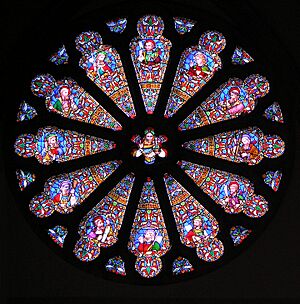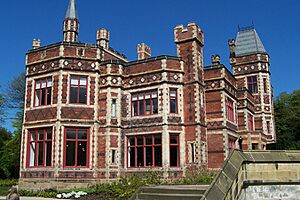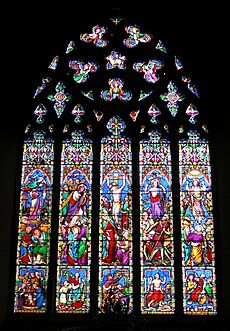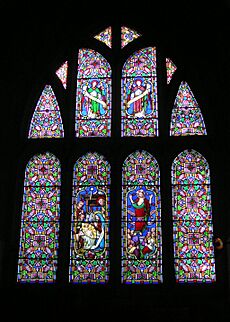William Wailes facts for kids
William Wailes (born in 1808, died in 1881) was a very important artist and business owner in England. He ran one of the biggest and busiest workshops that made stained glass windows. His work can be seen in many churches and buildings across the country.
Contents
William Wailes' Life and Work
William Wailes grew up in Newcastle on Tyne, a city in England known for making glass bottles. His first job was selling groceries and tea. But he also had a talent for art and practical skills. He set up a small oven, called a kiln, in his backyard. There, he made and baked small, colorful enamel decorations to sell in his shop.
In 1830, William traveled to Germany to learn more about designing and making stained glass. He studied with a famous artist named Mayer of Munich. By 1838, he opened his own studio to create stained glass windows. Just three years later, in 1841, his business started making its own glass.
Around 1842, a well-known architect named Augustus Pugin asked Wailes to make windows for his projects. Their work together lasted for about three years. William Wailes became very famous by making windows for many local churches. As his business grew, he hired more and more people. At one point, he had 76 employees! Some of his designers even went on to start their own successful stained glass companies.
William Wailes was one of only 25 stained glass makers who showed their work at the big Crystal Palace Exhibition in 1851. This was a huge event that showed off the best of British industry and art.
William married Elizabeth, and they had several children. His son, William Thomas Wailes, later joined the family business. In 1861, his son-in-law, Thomas Rankine Strang, also joined. At this time, the company became known as Wailes and Strang.
In 1860, William Wailes bought a large piece of land called the Saltwell Estate in Gateshead. He worked to improve the land, building a beautiful mansion for himself and designing the gardens. Later, he sold the property to the Gateshead Corporation. The estate then became a public park called Saltwell Park, which still includes his house, Saltwell Towers. William Wailes continued to live in his home until he passed away in 1881. His son, William Thomas Wailes, kept making stained glass until 1910.
Recognizing William Wailes' Art
A painter named John Oliphant painted a picture of William Wailes. In the painting, Wailes is shown next to one of his beautiful stained glass windows. This painting can be seen at the Shipley Art Gallery in Gateshead.
William Wailes' Stained Glass Art
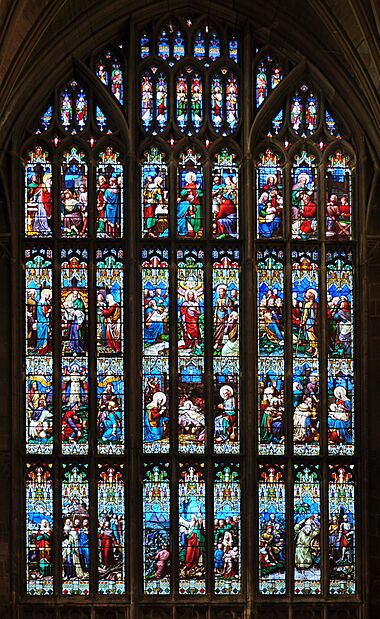
Wailes' Unique Style
Even though William Wailes had many designers working for him, you can often tell his windows apart. They have a special look because of the type of glass he used and his favorite color combinations. Wailes' glass often looks a bit lighter and brighter than windows made by other English workshops at the same time. It was more like glass from Germany.
He often used certain color pairs for the clothes of the figures in his windows. For example, you might see purple lined with bright red, yellow with bright blue, or red with a lively green. Many of Wailes' windows also feature a lot of pink glass.
William Wailes was known as a Gothic Revival artist. This means he used styles from old Gothic churches but gave them a fresh, new look. He could fill windows with fancy leaf patterns that looked like brightly painted old books, called illuminated manuscripts. His figures, however, were elegant and calm. They often communicated using a few common hand gestures.
The faces in Wailes' windows were painted in a soft, artistic way. This was different from some other artists of the 1800s who copied ancient windows with very sharp lines. This painterly style was something William Wailes learned when he trained with Mayer of Munich.
The Grand Window at Gloucester Cathedral
Most of William Wailes' work is found in the northern part of England. But he also received important jobs from further away. One of his most significant projects was creating the west window for Gloucester Cathedral. This was a huge and important job in the stained glass world.
The west window at Gloucester Cathedral was built around 1430 in the Perpendicular Gothic style. It is an enormous window with nine tall sections and four levels of glass. This window is at one end of the cathedral. At the other end, there is one of the largest ancient windows in the world, which is as big as a tennis court! Luckily, that old window still has much of its original glass from the 1300s.
Wailes' west window at Gloucester is an amazing achievement. It was a big challenge to make glass for such a vast space. His window does not try to look exactly like the older east window. The ideas for what to show in the west window were probably decided by a group of people. Because the window was so large, there was room for many stories and figures.
The main part of the window has nine vertical sections, called lights. These are divided into three groups of three by stone bars called mullions. The window rises in three main parts. The top and bottom parts are about half as tall as the middle one. Above these main sections are many smaller, vertical glass shapes. Wailes filled these with singing angels dressed in purple, bright red, and green robes.
Wailes' design divides the window's main part into four levels instead of three. Each level shows three detailed story scenes that stretch across all three vertical sections. The middle section is especially well-designed. It shows the Nativity of Christ (the birth of Jesus) and the Baptism of Christ in the Jordan by John the Baptist. These two important stories fit together beautifully, even though they are separate scenes.
Each of the twelve individual pictures in the window works well on its own. But the way the whole window is put together is very clever. It looks like one complete work of art. This was achieved by carefully placing all 116 figures and skillfully arranging the colors.
Churches with Stained Glass by William Wailes
In England
- St Andrew's Church, Bradfield, Berkshire
- St Mary's Church, Thatcham, Berkshire
- Church of St Peter and St Paul, Great Missenden, Buckinghamshire
- St Helen Witton's Church, Northwich, Cheshire
- Church of St Mary the Virgin, Ambleside, Cumbria
- All Saints' Church, Huntsham, Devon
- St John the Evangelist's Church, Birtley, County Durham
- St Helen's Church, Low Fell, County Durham
- Holy Trinity Church, Sunderland, County Durham
- Gloucester Cathedral
- St Edward's Church, Stow on the Wold, Gloucestershire
- St Matthias' Church, Richmond, Greater London
- St George's Cathedral, Southwark, Greater London
- St Mark's Church, St John's Wood, Greater London
- All Saints' Church, Hursley, Hampshire
- St Mary's Church, Kingsclere, Hampshire
- St George's Church, Benenden, Kent
- St Mary's Church, Chilham, Kent
- St Lawrence's Church, Waltham, Kent
- St Swithun's Church, Bintree, Norfolk
- St Andrew's Church, Blo' Norton, Norfolk
- St Andrew's Church, Bradenham, Norfolk
- St Maurice's Church, Briningham, Norfolk
- St Lawrence's Church, Castle Rising, Norfolk
- St Mary's Church, Colkirk, Norfolk
- St Peter's Church, Crostwick, Norfolk
- St Edmund's Church, Emneth, Norfolk
- St. Andrew's Church, Great Ryburgh, Norfolk
- St Peter and St Paul's Church, Swaffham Norfolk
- Hexham Abbey, Hexham, Northumberland
- St Mary's Church, Clipsham, Rutland
- St Mary's Church, Ellesmere, Shropshire
- St James the Less, Fradswell, Staffordshire
- St Editha's Church, Tamworth, Staffordshire
- St Martin's Church, Dorking, Surrey
- St John's Church, Piddinghoe, East Sussex
- Chichester Cathedral, Chichester, West Sussex
- St Mary's Church, Singleton, West Sussex
- St Botolph's Church, Farnborough, Warwickshire
- St Boniface's Church, Bonchurch, Isle of Wight
- St James' Church, Devizes, Wiltshire
- Church of St Anne, Catterick, North Yorkshire
- Bridlington Priory, Bridlington, East Yorkshire
- Church of St Thomas, Thurstonland, West Yorkshire
- St Martin's Church, Firbeck, South Yorkshire
- The Priory of St Peter and St Paul Brinkburn Priory, Brinkburn, Northumberland
- Newcastle Cathedral
- St Augustine's Church, Hedon, East Yorkshire
In Other Countries
- Cathedral of The Isles, Millport, Ayrshire, Scotland
- Sandyford Henderson Memorial Church, Glasgow, Scotland
- Christ Church St Laurence, Sydney, Australia
- Afghan Church, Mumbai, India
- First Presbyterian Church, Philadelphia, United States
Learn More
Other Stained Glass Artists and Companies
- Thomas Willement
- William Warrington
- Charles Edmund Clutterbuck
- Hardman & Co.
- Augustus Welby Pugin
Related Topics
- British and Irish stained glass (1811–1918)
- Poor Man's Bible


